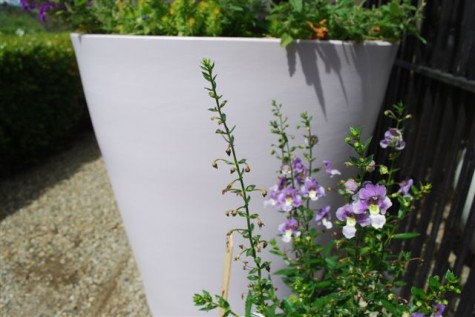
I hear too often from people that their pots peter out in August. There is no need for that, barring your dog unearthing them, or a hailstorm. I usually take my pots apart in November, as I am just plain tired of taking care of them. But here’s my formula for longevity through August and beyond. First off, water, and water properly-which can mean, water even when you don’t feel like it. This means soak your pots, and then let them get dryish before you water again. Secondly, deadhead regularly; do not let you annual flowers go to seed.
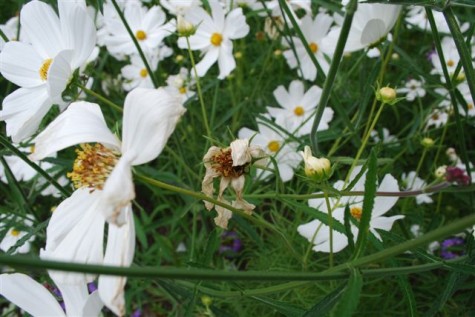
Here’s the biology behind the scenes. Annual plants by definition are plants that grow, flower, and set seed in one season. An annual which has successfully set seed has no biological reason to continue to flower. For those of you who think annuals bloom so the world will be a more beautiful place, here here. These plants flower for the purpose of reproduction-to insure the continuation of the species. If you prevent an annual from setting seed, it will continue to flower. There are plenty of flowers which are sterile, and do not set seed; they are popular for exactly this reason. Trailing verbena, on the other hand, will go out of flower quickly, if it is not deadheaded.
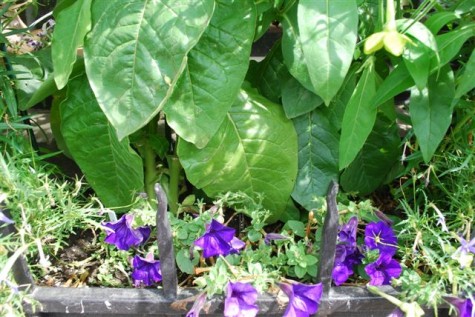 Plants grow in, and the room can get crowded. If the giant leaves of this nicotiana are allowed to shade the petunia, said petunia will pout, and finally give up. Removing leaves, or branches so everyone has a sunny spot, is good group management. A pot or window box is no place for a bully running amok. No one will like the result- least of all, you.
Plants grow in, and the room can get crowded. If the giant leaves of this nicotiana are allowed to shade the petunia, said petunia will pout, and finally give up. Removing leaves, or branches so everyone has a sunny spot, is good group management. A pot or window box is no place for a bully running amok. No one will like the result- least of all, you.
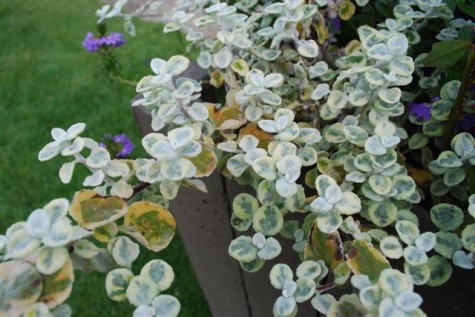 Try not to overwater. Put your finger down into the dirt. If the dirt sticks to you, there is probably enough moisture. Rotting leaves are unsightly. Worse yet, an environment that is too wet is an invitation to every fungus floating by, looking for a good home. Licorice likes dry conditions. Should you have been so bold to plant it next to an annual that loves water and more water, you’ve engineered a situation where individual plants in a community pot have to be watered on different schedules. This is not tough, just time-consuming.
Try not to overwater. Put your finger down into the dirt. If the dirt sticks to you, there is probably enough moisture. Rotting leaves are unsightly. Worse yet, an environment that is too wet is an invitation to every fungus floating by, looking for a good home. Licorice likes dry conditions. Should you have been so bold to plant it next to an annual that loves water and more water, you’ve engineered a situation where individual plants in a community pot have to be watered on different schedules. This is not tough, just time-consuming.
 Annuals need pruning, just like shrubs and trees. Pruning the flowers from your coleus plants result in densely growing coleus. Pruning plants at different heights gives everyone breathing room. Once a group of plants are put together in one pot, or one area, they take on a collective life. Sun, water and space have to be shared. And whatever the individual plants, you want an overall shape that looks great.
Annuals need pruning, just like shrubs and trees. Pruning the flowers from your coleus plants result in densely growing coleus. Pruning plants at different heights gives everyone breathing room. Once a group of plants are put together in one pot, or one area, they take on a collective life. Sun, water and space have to be shared. And whatever the individual plants, you want an overall shape that looks great. 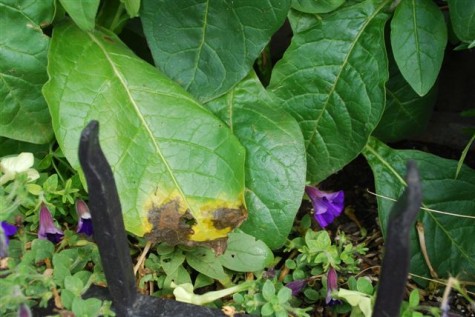
Plants that are healthy resist disease. Healthy means properly watered, fed, pruned and managed. If you do get a fungus, remove the diseased portions as soon as you can. Remove lower leaves in the interiors of your pots to promote good air circulation. Prevention is a lot easier that treatment. Sometimes weather conditions foster disease; I will spray with a fungicide if I have to. Safer’s soap will get rid of some insect pests-the trick is to apply 3 rounds, not one. Spider mites are notoriously difficult to get rid of. I avoid certain types of mandevilleas as they are so prone to them.
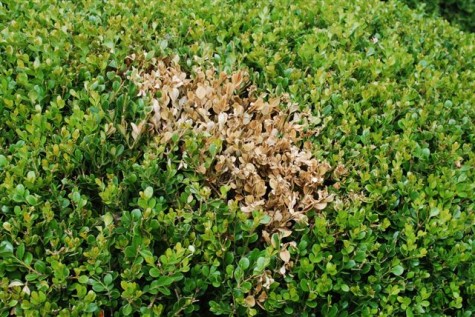 My beloved boxwood hedge was attacked this spring by a fungus called Volutella-I was beside myself over the damage. I had to get an expert to identify it for me; I have never seen this on boxwood before. We cleaned out, and raked up every dead leaf, and pruned out every infected branch with shears that were disinfected after each cut. Next spring I will spray for it. Imagine being a greenhouse grower-where plant illnesses and insects can threaten a livlihood. Most growers that I know practice close inspection of their plants, so they catch problems early. They also feed their plants; strong plants resist trouble. Once every seven to ten days I make sure my pots are thoroughly watered, then I liquid- feed them with a water soluble fertilizer with a big middle number (15-30-15) to encourage good flower production. This acts like a shot of vitamin B-12. Then I hold off watering as long as I can, so the plants take up the nutrients, before they get flushed out by the next round of watering.
My beloved boxwood hedge was attacked this spring by a fungus called Volutella-I was beside myself over the damage. I had to get an expert to identify it for me; I have never seen this on boxwood before. We cleaned out, and raked up every dead leaf, and pruned out every infected branch with shears that were disinfected after each cut. Next spring I will spray for it. Imagine being a greenhouse grower-where plant illnesses and insects can threaten a livlihood. Most growers that I know practice close inspection of their plants, so they catch problems early. They also feed their plants; strong plants resist trouble. Once every seven to ten days I make sure my pots are thoroughly watered, then I liquid- feed them with a water soluble fertilizer with a big middle number (15-30-15) to encourage good flower production. This acts like a shot of vitamin B-12. Then I hold off watering as long as I can, so the plants take up the nutrients, before they get flushed out by the next round of watering.
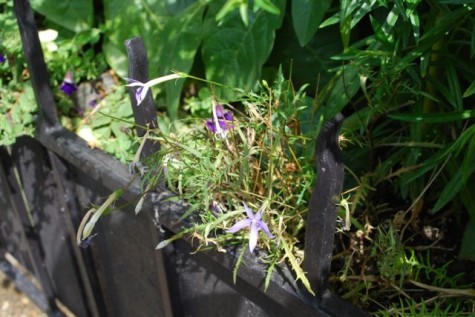
There will be those times when no amount of good growing practices and cultures will result in a good plant. Don’t be afraid to yank something that is clearly beyond rescue. Perfection applies only to diamonds and moments, remember?
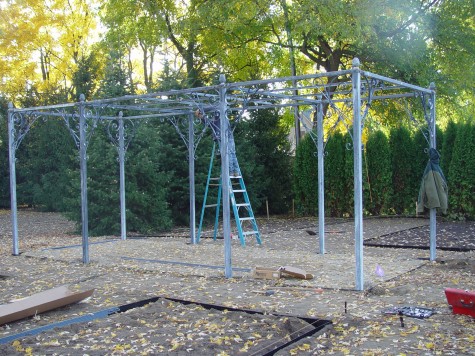
 This pavilion is very much about enclosure. It would be fine with vines, and fine without. The client who purchased this steel “building” had us construct cedar and steel benches for the sides; it became a place to meet in her garden.
This pavilion is very much about enclosure. It would be fine with vines, and fine without. The client who purchased this steel “building” had us construct cedar and steel benches for the sides; it became a place to meet in her garden.


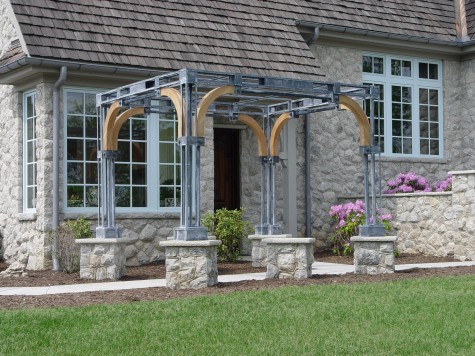
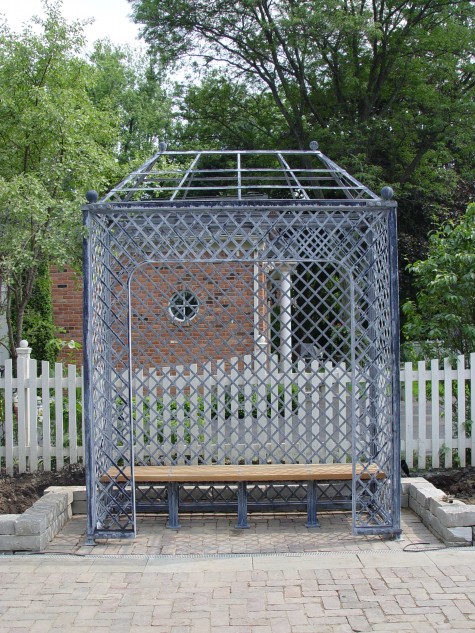
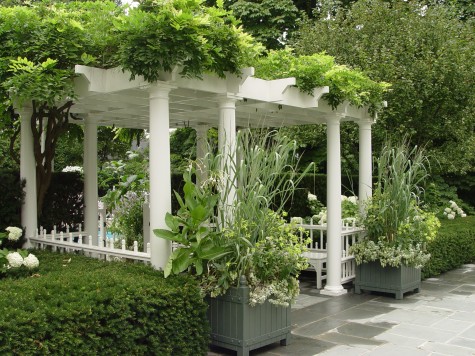
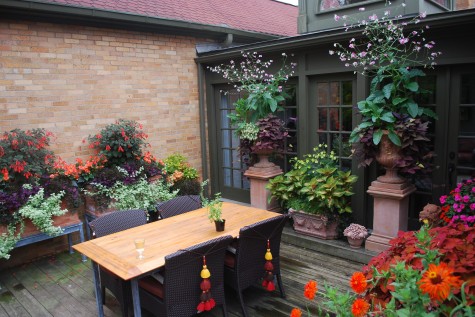
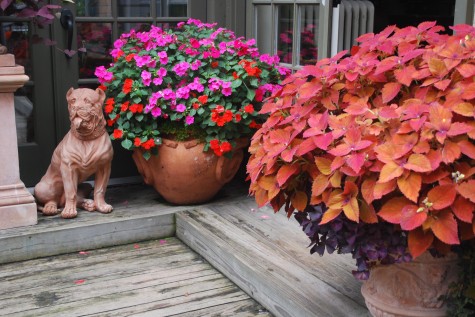 I like the fireworks going-on feeling of my terrace pots this year. Most of that has to do with how they have grown. I picked the colors and plants yes, but nature has proved unusually cooperative. We have had cool temperatures all summer, and now, regular rain. The usual bugs and disease must be at someone else’s house.
I like the fireworks going-on feeling of my terrace pots this year. Most of that has to do with how they have grown. I picked the colors and plants yes, but nature has proved unusually cooperative. We have had cool temperatures all summer, and now, regular rain. The usual bugs and disease must be at someone else’s house.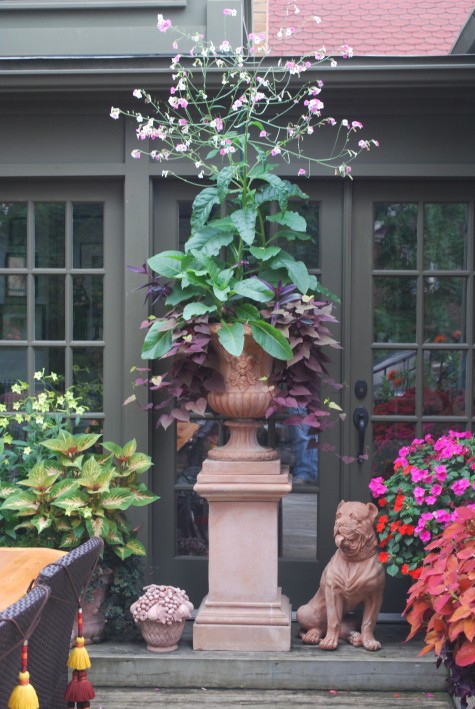 The Mital terra cotta gargoyle pots on their pedestals have never looked so rowdy and profuse. I grow nicotiana mutabilis every year for exactly the reason you see here. The showy oregano in this pot gave up and died, but I hardly notice. Besides, this pair of pots started out mismatched-I like that they will end up mismatched.
The Mital terra cotta gargoyle pots on their pedestals have never looked so rowdy and profuse. I grow nicotiana mutabilis every year for exactly the reason you see here. The showy oregano in this pot gave up and died, but I hardly notice. Besides, this pair of pots started out mismatched-I like that they will end up mismatched.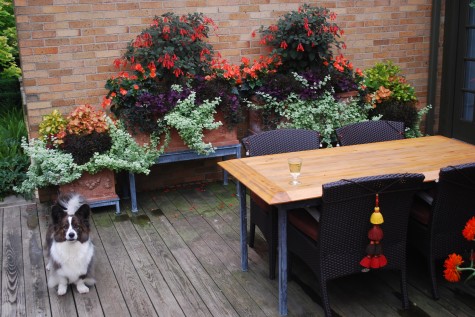
 These two licorice plants have made a flared skirt of themselves. The shape is especially attractive with the garland pattern on the pot. Did I plan this part-absolutely not. Anyone who gardens gets to enjoy the unexpected.
These two licorice plants have made a flared skirt of themselves. The shape is especially attractive with the garland pattern on the pot. Did I plan this part-absolutely not. Anyone who gardens gets to enjoy the unexpected.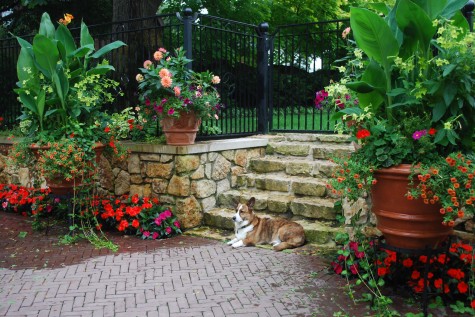 The New Guinea impatiens this year are unbelievably gaudy-what fun. Even my million bells, which usually sulk as I have very alkaline water, are cooperating. My dahlias do not have mites or mildew. The cool weather has slowed the flower production on the cannas, but the foliage alone is well worth having.
The New Guinea impatiens this year are unbelievably gaudy-what fun. Even my million bells, which usually sulk as I have very alkaline water, are cooperating. My dahlias do not have mites or mildew. The cool weather has slowed the flower production on the cannas, but the foliage alone is well worth having.
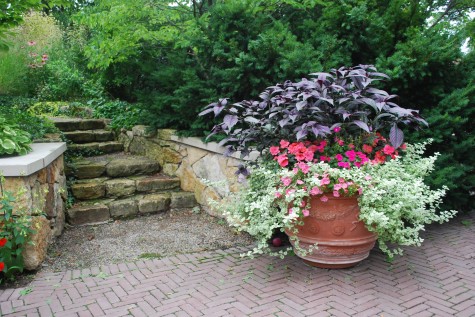
 I do have clients who are hands on; Dr. Luria is one of those. I designed his landscape, and gardens, and I have planted a few of the bigger evergreens for him-but by and large, he has done this work himself. I can relate to that gardener that really does like the dirt. The perennial garden sits on top of a low elliptical wall, which strongly borders the space while the garden is dormant.
I do have clients who are hands on; Dr. Luria is one of those. I designed his landscape, and gardens, and I have planted a few of the bigger evergreens for him-but by and large, he has done this work himself. I can relate to that gardener that really does like the dirt. The perennial garden sits on top of a low elliptical wall, which strongly borders the space while the garden is dormant. 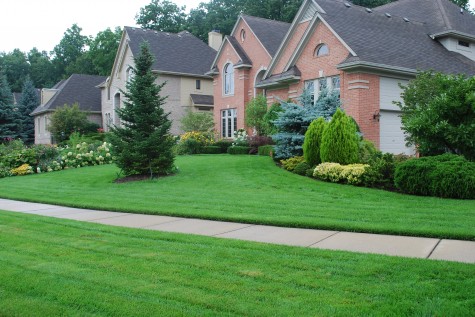 lI tried very hard to dissuade him from having a perennial garden in his front yard, but working against me was how the house sits on the property. This neighborhood has large common areas that all the homeowners share. Thus most of his property, and almost all of his sun is in the front yard. I need not have worried. This garden is better than well looked after. It is the jewel of the neighborhood.
lI tried very hard to dissuade him from having a perennial garden in his front yard, but working against me was how the house sits on the property. This neighborhood has large common areas that all the homeowners share. Thus most of his property, and almost all of his sun is in the front yard. I need not have worried. This garden is better than well looked after. It is the jewel of the neighborhood.
 In the back yard, The woodland common property is faced down with a mix of shade perennials. This greatly helps to expand the visual space of the rear yard. I suspect he takes care of the woodlot as well. A round terrace/deck is notable for its beautiful iron railings. What I dislike about decks the most is what I see underneath them; I rarely see a surface treatment I find attractive. The undersides of decks also tend to accumulate tools, hoses, toys and the like. This deck has the illusion of being solid to the ground; the vertical wood planks add so much color and texture to this small garden. The stairs hug the deck radius, and spill out onto a second terrace, finished simply in gravel contained by black aluminum edger strip. The blue furniture looks great.
In the back yard, The woodland common property is faced down with a mix of shade perennials. This greatly helps to expand the visual space of the rear yard. I suspect he takes care of the woodlot as well. A round terrace/deck is notable for its beautiful iron railings. What I dislike about decks the most is what I see underneath them; I rarely see a surface treatment I find attractive. The undersides of decks also tend to accumulate tools, hoses, toys and the like. This deck has the illusion of being solid to the ground; the vertical wood planks add so much color and texture to this small garden. The stairs hug the deck radius, and spill out onto a second terrace, finished simply in gravel contained by black aluminum edger strip. The blue furniture looks great. I so enjoy the gardens my clients make for themselves. Never would it occur to me to plant a cactus garden in an iron birdbath. Does this not look swell? I like everything about this small spot in his garden-the color, the textures-and most of all, the presence and personality of the head gardener.
I so enjoy the gardens my clients make for themselves. Never would it occur to me to plant a cactus garden in an iron birdbath. Does this not look swell? I like everything about this small spot in his garden-the color, the textures-and most of all, the presence and personality of the head gardener. Dr. Luria has been making things grow his whole life, and it shows. The plants are robustly happy and lush; how they look says everything about how much time he spends here. Though I am sure there are days he wonders what he took on here, the state of the garden gives no hint of that. Well grown plants are so much a part of what makes a garden beautiful.
Dr. Luria has been making things grow his whole life, and it shows. The plants are robustly happy and lush; how they look says everything about how much time he spends here. Though I am sure there are days he wonders what he took on here, the state of the garden gives no hint of that. Well grown plants are so much a part of what makes a garden beautiful.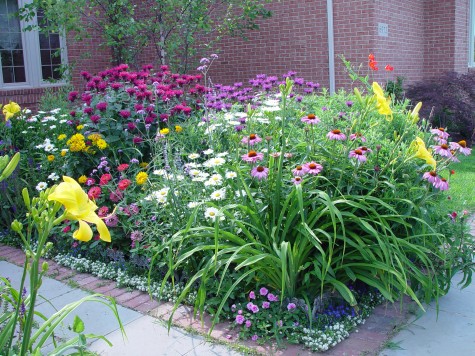 He also does a beautiful job of adding annuals to his perennial mix. Any day you go by, something interesting is going on. In any given year, the annuals he fancies can change the complexion of the entire garden. It looks new and fresh every year. He may consult with me about this or that, but he makes the decisions.
He also does a beautiful job of adding annuals to his perennial mix. Any day you go by, something interesting is going on. In any given year, the annuals he fancies can change the complexion of the entire garden. It looks new and fresh every year. He may consult with me about this or that, but he makes the decisions.
